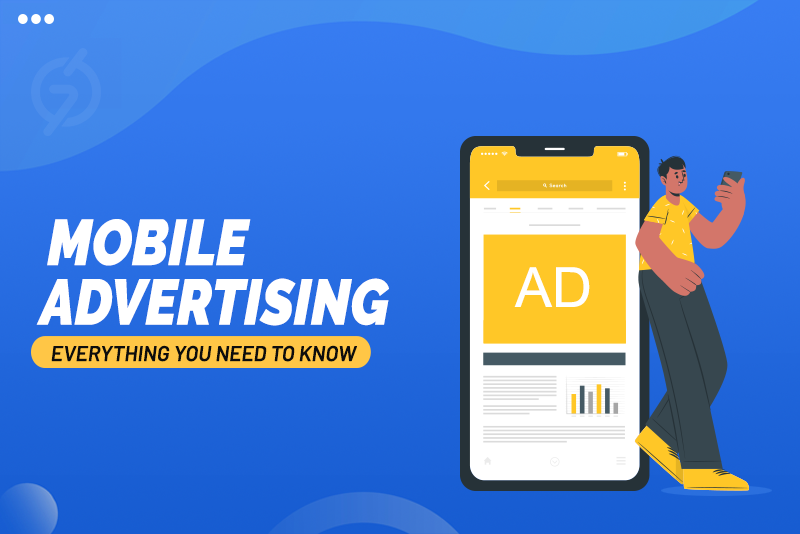Have you ever noticed those ads popping up on your phone while browsing your favorite apps or websites? That’s mobile advertising, one of the most effective ways to reach people online. With more and more people utilizing their phones to access the internet, it’s no wonder mobile advertising has become a big deal.
In fact, major brands are investing heavily in mobile ads, with global spending expected to exceed $495 billion by 2024! So, what makes mobile marketing so powerful? How can you use it to boost your business? And how does a company like Agility leverage mobile advertising to achieve marketing success?
In this blog post, we will respond to all these questions and more. By the end, you will understand why mobile advertising is a game-changer in digital marketing and how you can make it work for you. So, let’s begin!
Overview of Mobile Advertising
Mobile advertising refers to advertisements that appear on smartphones and other mobile gadgets, such as tablets and e-readers. This type of advertising has become increasingly important because mobile devices are widely used. It allows advertisers to reach users anytime and anywhere.
Types of Mobile Advertising
Here are some popular types of mobile ads are given below:-
Banner Ads:
Banner ads are a common form of mobile advertising. These ads are simple images or graphics alongside other content on websites or apps. They usually contain a clickable link that directs users to a product or service. Banner ads are often placed at the top or footing of a webpage or app screen.
Interstitial Ads:
Interstitial ads are full-screen advertisements that cover the entire interface of an app or website. They usually appear between different pages or screens, providing a more immersive advertising experience. Interstitial ads can include images, videos, or interactive elements to engage users.
Video Ads:
Video ads are becoming highly popular in mobile advertising. These ads are short video clips that play before, during, or after mobile video content. They can also appear within mobile apps or websites. Video ads provide an engaging way for advertisers to showcase their goods or services and capture users’ attention.
Native Ads:
Native ads are developed to blend in with the surrounding content, making them less intrusive to users. These ads correspond to the format and style of the website or app where they appear, seamlessly integrating with the user experience. Native ads can be articles, sponsored posts, or recommended content, providing a more organic and natural advertising approach.
Push Notifications:
Push notifications are alerts or messages sent directly to a user’s device. They appear on the home screen or in the notification center, even when the user is not actively using the app. Push notifications can deliver personalized offers, reminders, or updates from apps or brands, helping to keep users engaged and informed.
Location-Based Ads:
Location-based ads utilize the user’s current location to deliver targeted advertisements. These ads are designed to provide localized promotions or offers based on the user’s location. For example, a user in a shopping mall might receive ads for nearby stores or restaurants. Location-based ads can be delivered through mobile apps, websites, or text messages.
SMS Ads:
SMS (Short Message Service) ads are text messages sent directly to users’ mobile phones. These ads can contain promotional messages, offers, or information about products or services. SMS ads can reach users directly and effectively engage with customers who have opted in to receive such messages.
Playable Ads:
Playable ads are interactive advertisements that allow users to engage with the content. These ads are often seen in gaming apps and give users a taste of the game or app through a short, interactive experience. Playable ads let users try out the product or service before deciding.
Working of Mobile Advertising
Mobile advertising works by utilizing the unique features of mobile devices to deliver targeted and personalized ads. Here is how it typically works:
Ad Creation and Integration: Advertisers create ads specifically designed for mobile devices. These ads are then integrated into mobile apps or websites using software development kits provided by AdTech vendors.
Targeting and Personalization: Advertisers use demographic information, browsing behavior, past purchases, and preferences to tailor ads to specific audiences, making them more relevant and effective.
Ad Delivery: Ads are delivered through various channels, including mobile websites, mobile applications, SMS, and in-app advertising.
Performance Tracking: Mobile advertising platforms provide analytics and tracking tools to gauge the performance and efficacy of ad campaigns. Metrics such as impressions, clicks, conversions, and audience demographics are tracked to optimize campaigns.
Statistics and Market Trends
The mobile advertising market is increasing, driven by several key factors:
- Market Size and Growth: The global mobile advertising market was US$208.8 billion in 2023. It is expected to reach US$533.6 billion by 2032, with a growth rate of 10.7% from 2024 to 2032.
- Spending Projections: Worldwide mobile advertising spending will reach $402 billion in 2024. In the United States, mobile advertising expenditure is expected to exceed $216 billion in 2024.
- Mobile Traffic Dominance: As of 2024, mobile traffic accounts for 66.88%, compared to desktops’ 31.42%.
- E-commerce Influence: Mobile commerce makes up 72.9% of total e-commerce sales, highlighting the significant role of mobile devices in online shopping.
- User Engagement: About 65% of online sales are made through mobile devices, and 79% of people always have their smartphones with them.
Mobile Advertising’s Power in Digital Marketing
Mobile advertising is super essential for businesses looking to succeed online. Why?
Here are some reasons:
- Massive Reach: Almost everyone has a smartphone these days. That means mobile ads can reach many people, both young and old.
- Personalized Ads: Mobile ads can use your browsing history and other info to show you advertisements that you’ll find interesting. This makes ads more effective and less annoying.
- Location Targeting: Mobile ads can use GPS to show ads for businesses near you. This is especially helpful for local businesses like coffee shops and grocery stores.
- Interactive and Engaging: Mobile ads can be more interactive than traditional ads. You can play games, watch videos, and shop from the ad. This keeps people engaged and more likely to take action.
- Trackable Results: Mobile advertising platforms provide detailed reports showing your ads’ performance. This helps you see what’s working and adjust your campaigns as needed.
- Cost-Effective: Mobile advertising is typically cheaper than traditional advertising methods like TV or print, making it an excellent option for small businesses and startups.
Best Strategies and Practices for Effective Mobile Advertising
Effective mobile advertising requires careful planning and implementation. Here are some simple strategies and practices to make your mobile ads successful:
- Know Your Audience: Understand your target audience and what interests them. Modify your ads to their preferences and needs.
- Keep it Simple: Mobile screens are smaller, so make sure your ads are concise and easy to understand. Use clear and compelling visuals and a straightforward message.
- Optimize for Mobile: Ensure your ads are optimized for mobile devices. They should load fast and be effortless to navigate on smartphones and tablets.
- Use Clear Calls to Action: Include a clear and visible call to action in your ads. Tell users what you want them to do, such as “Shop Now” or “Learn More.”
- Test and Optimize: Continuously monitor and analyze your ads’ performance. Experiment with different approaches and optimize based on what works best.
- Leverage Mobile Features: Use mobile features like location targeting and push notifications to deliver personalized and targeted ads.
- Consider Native Advertising: Native ads blend in with the content and look natural, increasing user engagement and reducing ad resistance.
- Respect User Privacy: Ensure compliance with privacy regulations and acquire user consent for data collection and targeted advertising.
Future Trends in Mobile Advertising

Artificial Intelligence and Machine Learning
AI and ML are set to revolutionize mobile advertising by:-
- Enhancing ad targeting precision
- Automating ad creation and optimization
- Predicting user behavior and preferences
- Personalizing ad experiences in real-time
- Improving fraud detection and prevention.
Augmented Reality (AR) and Virtual Reality (VR)
AR and VR technologies will create immersive advertising experiences:-
- Virtual product try-ons and demonstrations
- Interactive brand storytelling
- Gamified ad experiences
- Location-based AR ads
- VR showrooms and virtual stores
5G Technology
The widespread adoption of 5G will impact mobile advertising by:-
- Enabling faster loading times for rich media ads
- Supporting higher-quality video and interactive content
- Improving location-based targeting accuracy
- Enhancing real-time bidding and ad delivery
- Facilitating seamless integration of IoT devices in advertising
Voice-activated Advertising
With the advancement of smart speakers and voice assistants, voice-activated ads will gain prominence:-
- Voice search optimization for ads- Interactive voice-based ads
- Voice-activated purchases and conversions
- Personalized audio ads based on user preferences
- Integration with smart home devices
Final Thoughts on Mobile Advertising:
Mobile ads are now a big deal in the world of online marketing. They come in lots of different styles, and they’re important because everyone uses their phones and tablets so much. Smartphones and new tech have changed how companies talk to their customers.
Programs that use AI (artificial intelligence) and machine learning help ads reach the right people in a way that’s both smart and effective. The future of mobile ads looks good! Since we all use our phones so much, advertisers need to ensure their ads work well on all devices and are super personalized.
Frequently Asked Questions (FAQs)
What’s Mobile Advertising?
Ans. Mobile advertising is a method of showing ads on your phone or tablet. Businesses use these ads to reach people like you when using apps, browsing websites, or searching for stuff online.
How Do Mobile Ads Target People?
Ans. Mobile ads can determine who you are based on your phone history, the apps you use, and where you are. This helps businesses show you ads that are more likely to grab your attention.
Are Mobile Ads Safe?
Ans. Yup, most mobile ads are safe. Businesses should use trusted ad networks to ensure their ads are delivered safely. Plus, they should protect your privacy and make sure you trust them.
How Can Businesses Control Mobile Ads?
Ans. Businesses can use ad management platforms like 7SearchPPC to manage their mobile ads. These platforms let them set their choices, track how well their ads are doing, and make changes to improve them. This helps businesses get the most out of their ad spending and reach the right people.
















